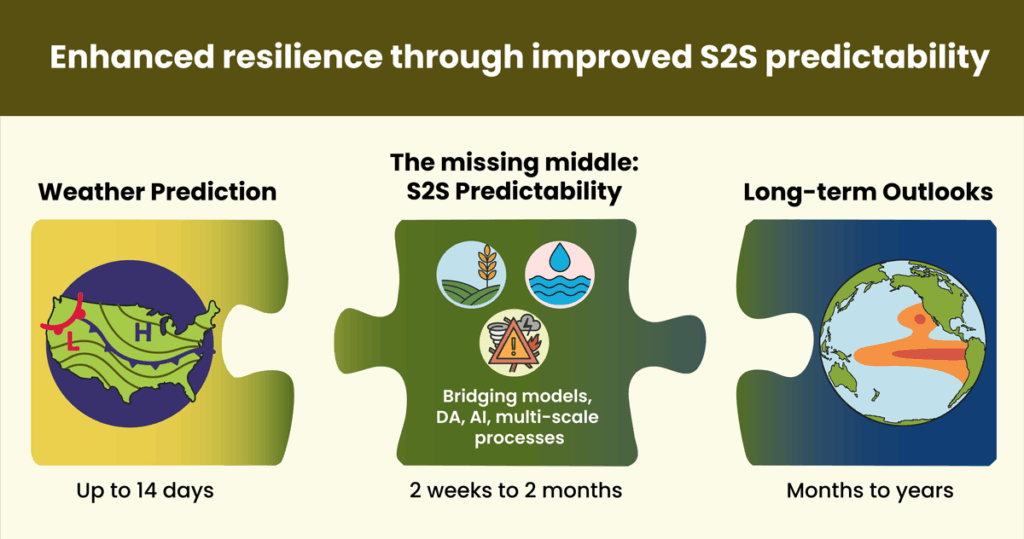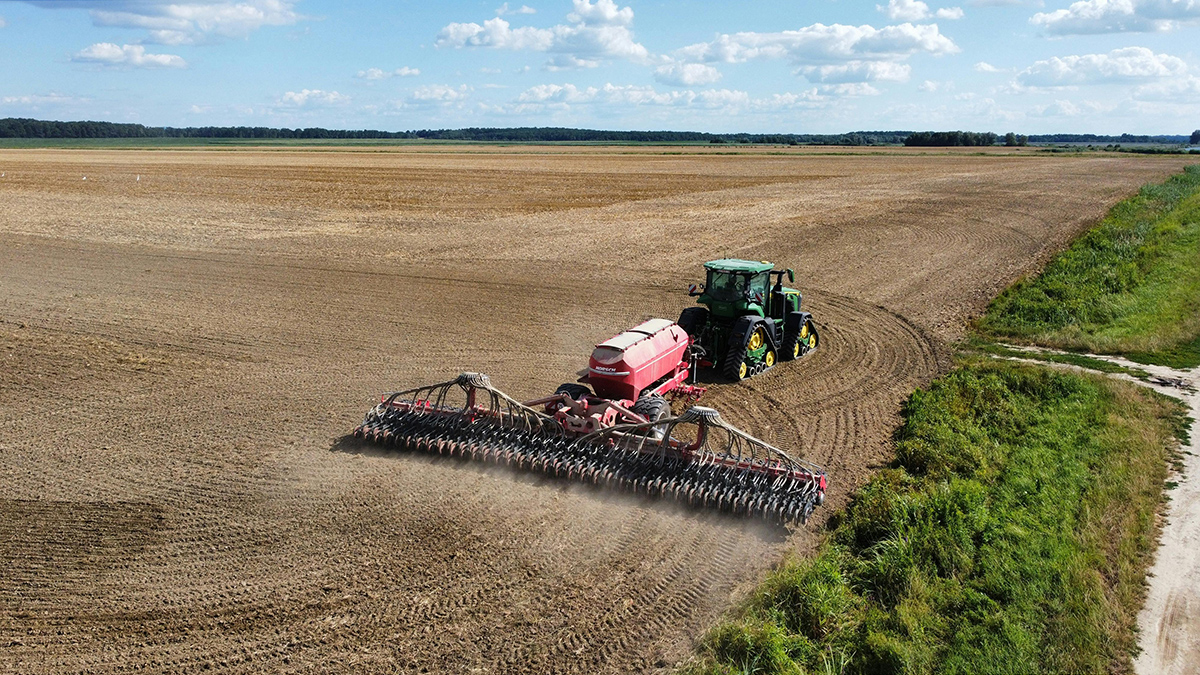Should I wear a jacket to work today, or will I be too warm? Will that hurricane miss my town, or should I prepare to evacuate? We rely on accurate short-term weather forecasts both to make mundane daily decisions and to warn us of extreme events on the horizon. At the same time, Earth system scientists focus on understanding what drives variations in temperature, precipitation, and extreme conditions over periods spanning months, decades, and longer.
Between those two ends of the forecasting spectrum are subseasonal-to-seasonal (S2S) predictions on timescales of 2 weeks to 2 months. S2S forecasts bridge the gap between short-term weather forecasts and long-range outlooks and hold enormous potential for supporting effective advance decisionmaking across sectors ranging from water and agriculture to energy, disaster preparedness, and more. Yet these timescales represent an underdeveloped scientific frontier where our predictive capabilities are weakest. Indeed, the S2S range is often referred to as the predictability desert.
Forecasts at 3- to 4-week lead times, for example, remain inconsistent. Sometimes, so-called windows of opportunity arise when models provide strikingly accurate, or skillful, guidance at this timescale. But these windows of skillful S2S forecasting are themselves unpredictable. Why do they occur when they do? Do they have recognizable precursors? And how does predictability depend on the quantity (e.g., temperature versus precipitation) being predicted?

These questions are more than academic curiosities. Answering them would transform our ability to gauge the value of S2S forecasts in real time and to anticipate and respond to high-impact events such as heat waves, flooding rains, drought onset, and wildfires.
Tackling this challenge requires traditionally siloed communities—scientists focused on predicting near-term weather and those focused on projecting long-term changes in the Earth system—to coordinate efforts. Together, these communities can advance scientific understanding and predictive capabilities across scales.
Discovering Windows of Opportunity
The challenges of subseasonal-to-seasonal (S2S) prediction reflect the complex and interconnected dynamics of the Earth system.
The challenges of S2S prediction reflect the complex and interconnected dynamics of the Earth system. At these lead times, forecast skill relies not only on the accuracy of initial input atmospheric conditions—always a vital element for weather forecasts—but also on model treatments of slowly evolving components of the Earth system. These components—including the ocean state, land surface conditions, snow cover, atmospheric composition, and large-scale patterns of variability such as the Madden-Julian Oscillation (MJO), El Niño–Southern Oscillation, stratospheric quasi-biennial oscillation, and sudden stratospheric warmings—interact in ways that enhance or degrade forecast performance. Volcanic eruptions can further influence these interactions, altering circulation patterns and modulating surface climate on S2S timescales.
Researchers have made substantial progress in understanding these individual Earth system components. But we still cannot reliably anticipate when models will yield skillful forecasts because their accuracy at S2S timescales is episodic and state dependent, meaning it comes and goes and depends on various interacting conditions at any given time. A model might perform well for a given region in one season—yielding a window of opportunity—but struggle in another region or season.
So how might we get better at anticipating such windows? For starters, rather than viewing the predictive capability of models as fixed, we can treat it as a dynamic property that changes depending on evolving system conditions. This paradigm shift could help scientists focus on developing tools and metrics that help them anticipate when forecasts will be most reliable. It could also suggest a need to rethink strategies for collecting environmental observations.
Just as predictability is episodic, so too might be the value of strategically enhanced observations. For example, targeted observations of sea surface temperatures, soil moisture, or atmospheric circulation during periods when these conditions strongly influence forecast skill could be far more valuable than the same measurements made at other times. Such adaptive, or state-aware, observing strategies, say, intensifying atmospheric sampling ahead of a developing MJO event, would mean concentrating resources where and when they will matter most. By feeding these strategically enhanced observations into forecast models, scientists could improve both the forecasts themselves and the ability to evaluate their reliability.
Aligning Goals Across Disciplines
S2S timescales fall at the intersection of weather forecasts and seasonal to decadal outlooks, and the communities working on those different types of predictions have different focuses and research strengths.
To drive needed technical advances supporting improved S2S predictability, we also need a cultural shift to remove barriers between scientific disciplines. S2S timescales fall at the intersection of weather forecasts and seasonal to decadal outlooks, and the communities working on those different types of predictions have different focuses and research strengths. Weather prediction emphasizes initial condition accuracy, data assimilation, and high-resolution modeling of fast atmospheric processes. Studying Earth system behavior and variability over longer timescales focuses on modeling slowly evolving boundary conditions (e.g., the ocean) and coupled component interactions (e.g., between the land and the atmosphere).
Historically, these communities have operated along parallel tracks, each with its own institutions, funding structures, and research priorities. The challenge of identifying windows of opportunity at S2S timescales offers a unifying scientific problem.
Earth system features that offer potentially promising signals of S2S predictability, such as the MJO, are already shared terrain, studied through the lenses of both weather and longer-term change. Extreme events are another area of convergence: Weather models focus on forecasting specific short-lived, high-impact events, whereas Earth system models explore the conditions and teleconnections that influence the likelihood and persistence of extremes. Together, these complementary perspectives can illuminate not only what might happen but why and when skillful forecasts are possible.
The path to unlocking S2S predictability involves more than simply blending models, though. It requires aligning the communities’ scientific goals, model performance evaluation strategies, and approaches for dealing with uncertainty. These approaches include the design of model ensembles, data assimilation strategies that quantify uncertainty in initial conditions, probabilistic evaluation methods, and ways of communicating forecast confidence to users.
The path forward also entails building modeling systems that capitalize on the weather community’s expertise in initialization and the Earth system modeling community’s insights into boundary forcing and component coupling. Accurate initialization must capture all Earth system components—from soil moisture, ocean heat content, and snow cover, for example, to the state of the atmosphere, including the stratosphere. However, observations and data assimilation for several key variables, especially in the ocean, stratosphere, and other data-sparse regions, remain limited, constraining our ability to represent their influences in prediction systems.
A near-term opportunity for aligning goals and developing models lies in improving prediction of MJO-related extreme rainfall events, which arise from tropical ocean–atmosphere interactions and influence regional circulation and precipitation. This improvement will require that atmospheric convection be better represented in models, a long-standing challenge in both communities.
Emerging kilometer-scale models and machine learning offer shared innovation and collaboration spaces. Kilometer-scale models can explicitly resolve convection, validate and refine model parameterizations, and elucidate interactions between large-scale circulation and small-scale processes. Machine learning provides new avenues to emulate convection-permitting simulations, represent unresolved processes, and reduce systematic model errors.
Success with this challenge could yield immediate value for science and decisionmaking by, for example, enabling earlier warnings for flood-prone areas and supporting more informed planting and irrigation decisions in agriculture.
From Forecast Skill to Societal Resilience
The societal need for more skillful S2S prediction is urgent and growing. Communities worldwide are increasingly vulnerable to extreme conditions whose impacts unfold on weekly to monthly timescales. In scenarios such as a prolonged dry spell that turns into drought, a sudden warming trend that amplifies wildfire risk, or a stalled precipitation pattern that leads to flooding, insights from S2S forecasting could provide foresight and opportunities to prepare in affected areas.
Officials overseeing water management, energy planning, public health, agriculture, and emergency response are all seeking more reliable guidance for S2S time frames. In many cases, forecasts providing a few additional weeks of lead time could enable more efficient resource allocation, preparedness actions, and adaptation strategies. Imagine if forecasts could reliably indicate prolonged heat waves 3–4 weeks in advance. Energy providers could prepare for surges in cooling demand, public health officials could implement heat safety campaigns, and farmers could adjust planting or irrigation schedules to reduce losses.
The resilience of infrastructure, ecosystems, and economies hinges on knowing not only what might happen but also when we can trust our forecasts. By focusing on understanding when and where we have windows of opportunity with S2S modeling, we open the door to developing new, intermediate-term forecasting systems that are both skillful and useful—forecast systems that communicate confidence dynamically and inform real-world decisions with nuance.
Realizing this vision will require alignment of research priorities and investments. S2S forecasting and modeling efforts have often fallen between the traditional mandates of agencies concerned with either weather or longer-term outlooks. As a result, the research and operational efforts of these communities have not always been coordinated or sustained at the scale required to drive progress.
Coordination and Collaboration
With growing public attention on maintaining economic competitiveness internationally and building disaster resilience, S2S prediction represents an untapped opportunity space. And as machine learning and artificial intelligence offer new ways to explore predictability with models and to extract meaningful patterns from model outputs, now is the time to advance the needed coordination.
The many use cases for S2S prediction underscore that it isn’t just a scientific challenge, it’s a strategy for achieving resilience and prosperity.
The many use cases for S2S prediction underscore that it isn’t just a scientific challenge, it’s a strategy for achieving resilience and prosperity. We call on a variety of communities and enterprises to collaborate and rally around the challenge of illuminating windows of opportunity in S2S modeling.
Scientists from traditionally distinct disciplines should codesign research strategies to jointly investigate when, where, and why S2S skill emerges. For example, they could examine weather regimes (e.g., the Pacific or Alaska ridges) and their links to modes of variability (e.g., the North Atlantic Oscillation) and leverage data assimilation to better understand how these phenomena evolve across timescales.
The scientific community could also identify and evaluate critical observational gaps that limit progress in modeling and data assimilation. And they could develop strategies to implement adaptive observing approaches that, for example, target soil moisture, surface energy fluxes, and boundary layer profiles to better capture land-atmosphere interactions at S2S timescales. Such approaches would help to fill gaps and advance understanding of key Earth system processes.
Modeling centers could build flexible prediction systems that allow for advanced data assimilation and incorporate robust coupling of Earth system components—drawing from the weather and Earth system modeling communities, respectively—to explore how initial conditions and boundary forcing jointly influence S2S skill. Using modular components—self-contained pieces of code that represent individual Earth system processes, such as atmospheric aerosols and dynamic vegetation—within these systems could help isolate sources of predictability and improve process-level understanding.
To sustain progress initiated by scientists and modeling centers, agencies and funders must recognize S2S prediction as a distinct priority and commit to investing in the needed modeling, observations, and institutional coordination.
Furthermore, it’s essential that scientists, decisionmakers, and end users codevelop forecast tools and information. Close integration among these groups would focus scientific innovation on user-defined needs of what is useful and actionable, allowing scientists to build tools that meet those needs.
S2S forecasting may never deliver consistent skill across all timescales and regions, but knowing when and where it is skillful could make it profoundly powerful for anticipating high-impact hazards. Can we reliably predict windows of opportunity to help solve the predictability desert? Let’s do the work together to find out.
Author Information
Jadwiga H. Richter ([email protected]) and Everette Joseph, National Science Foundation National Center for Atmospheric Research, Boulder, Colo.

